非谓语动词的时态和语态问题
非谓语动词的时态和语态

非谓语动词的时态和语态非谓语动词是指在句中不充当谓语成分,通常以动词原形或动词的其他非限定形式呈现的动词。
非谓语动词的时态和语态主要根据上下文确定,本文将详细介绍非谓语动词的时态和语态的使用。
一、非谓语动词的时态1. 不定式:不定式作为非谓语动词形式,不受时态的限制,通常表示动作发生在谓语动词所表示的动作之前。
例如:- To understand English well, one must practice every day.(为了能够很好地理解英语,人们必须每天练习。
)- I forgot to buy milk on the way home.(我从没想到,在回家的路上忘了买牛奶。
)2. 现在分词:现在分词作为非谓语动词形式,通常表示与谓语动词所表示的动作同时或一般性的动作。
例如:- Walking along the street, I noticed a small cafe.(在街上走的时候,我注意到了一家小咖啡馆。
)- The teacher was talking to the students, explaining the new lesson.(老师正在和学生们谈话,解释新的课程。
)3. 过去分词:过去分词作为非谓语动词形式,通常表示在谓语动词所表示的动作之前已经完成的动作。
例如:- Having finished his homework, the boy went out to play.(孩子做完作业后,出去玩了。
)- The injured man was taken to the hospital, accompanied by his family.(受伤的人被他的家人陪同着送到了医院。
)二、非谓语动词的语态非谓语动词的语态主要包括主动语态和被动语态,具体如下:1. 不定式的语态:不定式的语态通常与主句的语态保持一致。
例如:- She wants to be promoted.(她想要升职。
非谓语动词解题策略三步法3-语态与时态的确定原则
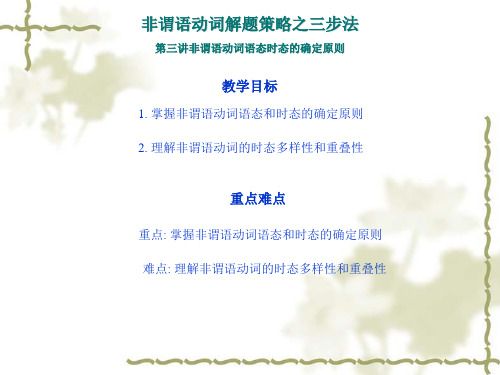
D. 完成进行式
在非谓语动词中,只有不定式存在完成进行主动式。其表示不定式所表示的动 作/状态一直延续到句中谓语动词所表示的动作(记作符号“→∣”)。如: She is said to have been living abroad these years. 据说这些年来他一直在国外生活。
非谓语动词解题策略之三步法
B. 当非谓语动词在句中作定语时,应考虑非谓语动词和所修饰n./pron.之间的 关系;
C. 当非谓语动词在句中作宾语补足语时,应考虑非谓语动词和宾语之间的关系;
非谓语动词解题策略之三步法
第三讲非谓语动词语态时态的确定原则
Ⅱ. 非谓语动词 时态的确定原则
非谓语动词的时态是指谓语动词所表示的动作或状态与主要动词(谓语动词)所表示 的动作或状态比较时,两者在发生时间上的先后关系。 A. 一般式 1. 不定式 a. 表示经常性动作/状态或没有明确的先后关系。如: To see is to believe. 眼见为实。 She hates to be flattered. 她不喜欢被奉承。
Ⅰ. 非谓语动词语态的确定原则
非谓语动词的语态是指非谓语动词与其逻辑主语之间的关系。一般地,如果二 者是主谓关系,则非谓语动词用主动式,如果二者是动宾关系,则非谓语动词 使用被动式。 非谓语动词的逻辑主语与其句法功能相关,一般地,
A. 当非谓语动词在句中作表语、宾语、主语补足语和状语时,应考虑非谓语 动词和句子主语的关系;
初中英语非谓语动词的时态和语态

非谓语动词的时态和语态非谓语动词的时态和语态形式一、非谓语动词的时态(不含过去分词)一般式:非谓语动词的一般式表示的动作可以与谓语动词表示的动作同时发生或发生在谓语动词表示的动作之前或之后。
I saw he go out/going out.He stood there crying.He insisted on joining the army.Thank you for giving us so much help.完成式:非谓语动词的完成式表示的动作发生在谓语动词表示的动作之前I am sorry to have kept you waiting.He was praised for having taught for 60 years.Having finished the work he went home.不定式的完成式和完成进行式:只有动词不定式有这两种时态。
其进行式表示的动作正在进行,与谓语动词表示的动作同时发生;其完成进行式表示的动作在谓语动词表示的动作之前一直进行。
They seems to be getting along well now.We’re happy to have been working with you.二、非谓语动词的语态(不含过去分词)一般被动式I’m glad to be invited here.He did it without being asked.The building being built is our school.The book is said to have been translated into chinese.It’ said that 据说…sb./sth. be said to do sth.据说某人某物…She has no memory of having been praised.The plan having been made, he carried it out at once.。
非谓语动词知识点总结

非谓语动词知识点总结非谓语动词知识点总结非谓语动词,又叫非限定动词,非谓语动词是指在句子中不是谓语的动词,接下来是小编为您整理的非谓语动词知识点总结,希望对您有所帮助。
I.概述1.基本形式的变化:不定式:时态主动态被动态一般式to doto be done进行式to be doing完成式to have builtto have been builtJohn said that he had run in order to catch the bus. (一般式的主动态)He hated to be misunderstood by others. (一般式的被动态) He pretended to be listening attentively. (进行式)He intended to have told you that. (完成式主动态)This work of art seemed to have been created several centuries ago. (完成式的被动态)v-ing形式时态主动态被动态一般式doingbeing done完成式having donehaving been done注意:不及物动词没有被动式动名词I am sure of his coming in time. (一般式主动态) (= I am sure that he will come in time)He is proud of being selected as monitor. (一般式被动态) (= He is proud that he is selected as monitor.)I’m confident of his having passed the exam. (完成式主动态) (= I am confident that he have passed the exam.)He complained of having been cheated by others. (完成式被动态)现在分词He sat in a chair,reading a novel. (一般式主动态)Being exhausted by work, he fell asleep quickly. (一般式被动态)Having finished his homework, he went playing. (完成式主动态)All this having been settled, he went home. (完成式被动态)2.所做成分项目/成分主语表语宾语宾补定语状语动词的ing形式现在分词△ △△△动名词△△△ △不定式△△△△△△过去分词△ △△△注:现在分词、不定式、过去分词都可以作独立成分。
非谓语动词的时态和语态在句子中的运用
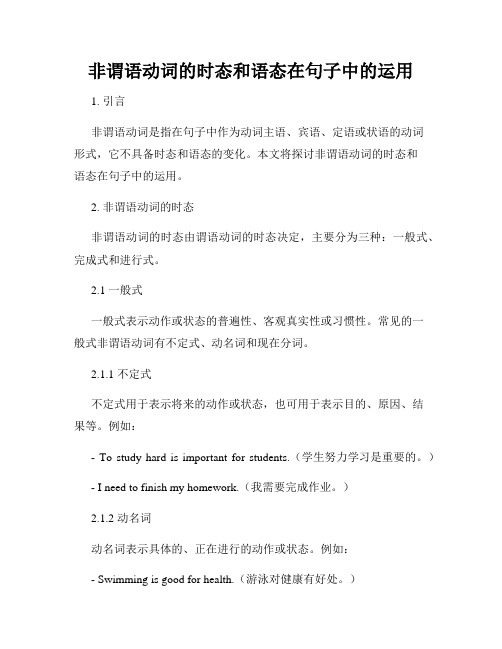
非谓语动词的时态和语态在句子中的运用1. 引言非谓语动词是指在句子中作为动词主语、宾语、定语或状语的动词形式,它不具备时态和语态的变化。
本文将探讨非谓语动词的时态和语态在句子中的运用。
2. 非谓语动词的时态非谓语动词的时态由谓语动词的时态决定,主要分为三种:一般式、完成式和进行式。
2.1 一般式一般式表示动作或状态的普遍性、客观真实性或习惯性。
常见的一般式非谓语动词有不定式、动名词和现在分词。
2.1.1 不定式不定式用于表示将来的动作或状态,也可用于表示目的、原因、结果等。
例如:- To study hard is important for students.(学生努力学习是重要的。
)- I need to finish my homework.(我需要完成作业。
)2.1.2 动名词动名词表示具体的、正在进行的动作或状态。
例如:- Swimming is good for health.(游泳对健康有好处。
)- I enjoy reading books.(我喜欢读书。
)2.1.3 现在分词现在分词表示被动或进行的动作或状态。
例如:- The boy standing there is my brother.(站在那儿的男孩是我的弟弟。
)- The book written by him is famous.(由他写的那本书很有名。
)2.2 完成式完成式表示动作已经完成或发生在谓语动词之前。
常见的完成式非谓语动词有完成式不定式、完成式动名词和过去分词。
2.2.1 完成式不定式完成式不定式表示在谓语动词之前完成的动作。
例如:- He seems to have forgotten everything.(他似乎忘记了一切。
)- I am glad to have finished the task.(我很高兴完成了任务。
)2.2.2 完成式动名词完成式动名词表示在谓语动词之前完成的动作。
例如:- Having studied for two hours, he finally understood the concept.(经过两个小时的学习,他终于理解了这个概念。
非谓语动词的时态和语态问题

非谓语动词的时态和语态问题一、非谓语动词的时态问题不定式或动词的-ing形式(包括现在分词和动名词)的动作若发生在谓语动词的动作之前,用完成式,否则就用一般式。
例:1.I don’t know whether you happen________,but I’m going to study in the U. S. A. this September. (辽宁卷)A. to be heardB. to be hearingC. to hearD. to have heard【分析】答案选D。
hear发生在谓语don’t know之前,用不定式的完成式。
句意是:我不知道你是否已经听说过了,今年九月我要去美国学习。
2.The old man,________ abroad for twenty years, is on the way back to his motherland. (江苏卷)A. to workB. workingC. to have workedD. having worked【分析】答案选D。
work发生在谓语(返回祖国)之前,用现在分词的完成式作状语,表示时间,相当于after he has worked abroad…不定式作状语不能表示时间。
3.“We can’t go out in this weather,” said Bob,________ out of the window. (四川卷)A. lookingB. to lookC. lookedD. having looked【分析】答案选A。
look out of the window与谓语动词said同时发生,用现在分词的一般式作状语,表示伴随情况。
若表示不定式的动作与谓语动作同时发生,并强调正在进行的情景或持续性,可用进行式。
如:He seems to be reading a newspaper. 他好像在看报。
系统学习语法非谓语动词的时态与语态变化
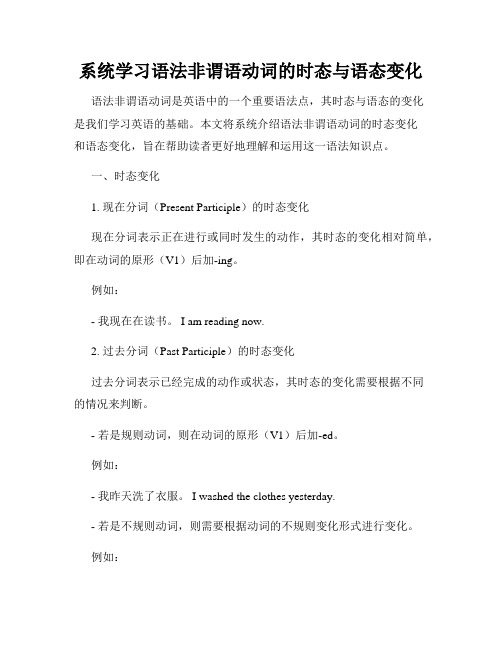
系统学习语法非谓语动词的时态与语态变化语法非谓语动词是英语中的一个重要语法点,其时态与语态的变化是我们学习英语的基础。
本文将系统介绍语法非谓语动词的时态变化和语态变化,旨在帮助读者更好地理解和运用这一语法知识点。
一、时态变化1. 现在分词(Present Participle)的时态变化现在分词表示正在进行或同时发生的动作,其时态的变化相对简单,即在动词的原形(V1)后加-ing。
例如:- 我现在在读书。
I am reading now.2. 过去分词(Past Participle)的时态变化过去分词表示已经完成的动作或状态,其时态的变化需要根据不同的情况来判断。
- 若是规则动词,则在动词的原形(V1)后加-ed。
例如:- 我昨天洗了衣服。
I washed the clothes yesterday.- 若是不规则动词,则需要根据动词的不规则变化形式进行变化。
例如:- 我吃了晚饭。
I have eaten dinner.3. 动词不定式(Infinitive)的时态变化动词不定式表示目的或未来的动作,其时态的变化相对简单,即在动词的原形(V1)前加to。
例如:- 我打算明天去购物。
I plan to go shopping tomorrow.二、语态变化语态是英语中的一个重要语法点,包括主动语态和被动语态。
在非谓语动词中,语态的变化需要根据时态来确定。
1. 主动语态(Active Voice)的语态变化主动语态表示主语是动作的执行者,变化相对简单,即保持非谓语动词的原形形式。
例如:- 我正在听音乐。
I am listening to music.2. 被动语态(Passive Voice)的语态变化被动语态表示主语是动作的承受者,变化需要根据不同的时态来确定。
- 现在分词的被动语态变化为:be + being + 过去分词例如:- 她正在被教授指导。
She is being taught by the professor.- 过去分词的被动语态变化为:be + 过去分词例如:- 他被邀请参加宴会。
非谓语动词时态和语态的结构及短语

非谓语动词时态和语态的结构1. 不定式有哪些时态和语态呢?主动被动一般时to do to be done进行时to be doing 无完成时to have done to have been done 完成进行式to have been doing 无2. 动名词的时态和语态主动被动一般时doing being done完成时having done having been done 3. 分词的时态和语态主动被动现在分词一般时doing being done现在分词完成时having done having been done 过去分词无done中考英语非谓语动词总结一.接动词不定式(to do/ do sth)1. do nothing but do sth除了做某事外不做任何事2. be supposed to do sth应该做某事;被期望干某事3. Let's (not ) do sth4.want to do sth5.want sb to do sth7.ask sb (not ) to do sth8.stop to do sth停下来去做某事9.tell sb (not ) to do sth10.watch sb do sth观察某人做某事11.It's time (for sb) to do sth到了该去做某事的时间12.help sb (to ) do sth13.help do sth14.make sb do sth15.decide (not ) to do sth决定做某事16.find it +adj + to do sth17.have to do sth必须做某事18.try (not ) to do sth尽力做某事19.try one's best to do sth尽某人最大能力做某事20.It's +adj +(for)of +sb + to do sth21.plan to do sth计划去做某事22.S.p.+be a good place to do sth23.It takes sb +some time + to do sth做某事花费某人多长时间24.send sb to do sth派某人做某事25.invite sb to do sth邀请某人做某事26.forget to do sth忘记要去做某事27.live to be +时间活到…28.be able to do sth能够做某事29.have sth to do 有事要做30.seem to do sth似乎做;好像31.get sb /sth to do sth32.疑问词+ to do sth33.need sth to do sth需要……做某事e sth to do sth用某物来做某事35.follow sb to dosth跟随某人做某事36.need to do sth需要做某事37.a good time to do sth做某事的好时候38.the best time to do sth 做某事的最好时间39.the best way to do sth做某事最好的方法40.be the first / last one to do sth最后一个或者第一个(人或事吧)去做某事41.would like to do sth想要做某事42.be excited /surprised to do sth对做某事感到兴奋43.be useful to do sth有助于做某事44.be allowed to do sth被允许做某事45.allow sb to do sth允许某人做某事46.It's better to do sth干某事比较好47.It's best to do sth48.take care (not) to do sth小心(不要)做某事49.see sb do sth看见某人做了某事50.why not do sth ?51.have enough time to do sth有足够的时间干某事52.too…to do sth太…以至于不能53.not…enough to do sth 不-----足够做某事54.encourage sb to do sth鼓励某人做某事55.choose to do sth选择做某事56.wait to do sth等着做某事57.be happy/glad/pleased to do sth高兴做某事58.make it +adj + to do sth59.be careful to do sth小心做某事60.be afraid to do sth害怕去做某事61.It's our duty to do sth做某事是我们的责任ed to do sth过去常做某事63.can't afford to do sth不能担负起干某事64.make a decision to do sth决定做某事65.have an opportunity to do sth有做某事的机会66.wait for sb to do sth等待某人做某事67.would do sth rather than do sth宁愿做某事不愿做某事68.would rather do sth than do sth宁愿做某事不愿做某事69.hurry to do sth匆忙去做某事70.refuse to do sth拒绝干某事71.agree to do sth同意干某事72.pretend to do sth假装做某事73.pretend to be doing sth假装正在做某事74.prefer to do sth更喜欢做某事75.prefer not to do sth76.prefer to do sth raher than do sth77.be willing to do sth乐意去做某事78.volunteer +时间/ 钱+ to do sth79.volunteer to do sth自愿去做某事80.offer to do sth提出要做…81.rush to do sth赶着做某事82.in order (not ) to do sth为了做某事83.be certain to do sth一定做…84.be sure to do sth一定会做某事85.make plans to do sth制定计划做某事86.go out of one’s way to do sth特别费心地(为某人)做某事87.lead sb to do sth致使某人做某事88. warn sb to do sth警告某人做某事89.It's one's turn to do sth该轮到某人做某事90.urge sb to do sth敦促某人做某事91.Could /Would you please (not) do sth ? 请你(不要)做某事好吗?92.it is great fun to do sth做…很有趣二、接动名词(doing sth)1.like doing sth3.have great fun doing sth做…玩得很高兴4.be interested in doing sth对做某事感兴趣5.Thanks for doing sth感谢某人做某事6.look at sb doing sth看到某人做某事7.stop sb doing sth阻止某人做某事8.stop sb from doing sth阻止某人做某事9.go + v-ing10.do the (some )+v-ing11.What/How doing sth ?12.practice doing sth练习做某事13.watch sb doing sth观察某人正在做某事14.find sb doing sth发现某人正在做某事15.mind (one's ) doing sth介意(某人)做某事。
非谓语动词的时态和语态
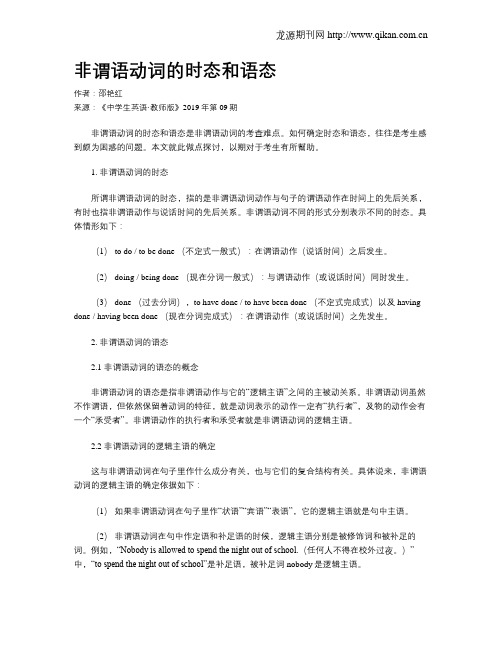
非谓语动词的时态和语态作者:邵艳红来源:《中学生英语·教师版》2019年第09期非谓语动词的时态和语态是非谓语动词的考查难点。
如何确定时态和语态,往往是考生感到颇为困惑的问题。
本文就此做点探讨,以期对于考生有所幫助。
1. 非谓语动词的时态所谓非谓语动词的时态,指的是非谓语动词动作与句子的谓语动作在时间上的先后关系,有时也指非谓语动作与说话时间的先后关系。
非谓语动词不同的形式分别表示不同的时态。
具体情形如下:(1) to do / to be done (不定式一般式):在谓语动作(说话时间)之后发生。
(2) doing / being done (现在分词一般式):与谓语动作(或说话时间)同时发生。
(3) done (过去分词),to have done / to have been done (不定式完成式)以及having done / having been done (现在分词完成式):在谓语动作(或说话时间)之先发生。
2. 非谓语动词的语态2.1 非谓语动词的语态的概念非谓语动词的语态是指非谓语动作与它的“逻辑主语”之间的主被动关系。
非谓语动词虽然不作谓语,但依然保留着动词的特征,就是动词表示的动作一定有“执行者”,及物的动作会有一个“承受者”。
非谓语动作的执行者和承受者就是非谓语动词的逻辑主语。
2.2 非谓语动词的逻辑主语的确定这与非谓语动词在句子里作什么成分有关,也与它们的复合结构有关。
具体说来,非谓语动词的逻辑主语的确定依据如下:(1)如果非谓语动词在句子里作“状语”“宾语”“表语”,它的逻辑主语就是句中主语。
(2)非谓语动词在句中作定语和补足语的时候,逻辑主语分别是被修饰词和被补足的词。
例如,“Nobody is allowed to spend the night out of school.(任何人不得在校外过夜。
)”中,“to spend the night out of school”是补足语,被补足词nobody是逻辑主语。
非谓语动词的时态和语态

注意①动名词的复合结构就是在动名词前加上它的逻辑主语。
其形式为:名词所有格/普通格/人称代词宾格/形容词性物主代词+动名词。
His not coming to my birthday party made me a little anxious.他没来我的生日聚会使我有点担心。
I remember Jane's/Jane going there.我记得简去过那里。
②过去分词本身表被动完成,所以没有主动语态和被动语态之分。
③非谓语动词的否定式是在非谓语动词前加not。
2.作结果状语动词不定式作结果状语,其逻辑主语通常亦是全句的主语。
常在so/such ...as to, enough to ...,only to ...以及too ...to ...等结构中表示结果。
He hurried to the station only to find the train had already left.他匆忙赶到车站,发现火车已经离开。
3.作原因状语不定式作状语表示原因,往往用在表示情感或态度的形容词后。
She was glad to hear the news that she had passed the driving test.听到她通过驾照考试的消息后,她很高兴。
4.作条件状语不定式作状语表条件,可改成相对应的条件状语从句。
To turn to the left(=If you turn to the left), you could find a big park.向左拐,你会发现一个大公园他们的车被困在了拥挤的交通中,因此耽搁了。
(6)表示方式或伴随情况,翻译时一般译成并列复合句。
He made the boy sit there, promising he would not hurt him.他让男孩坐在那,答应不伤害他。
The professor came into the classroom,followed by some students.教授走进教室,几个学生跟在后面。
非谓语动词的时态和语态

The problem____ next is of great C ___ importance. The problem____ B now __ is of great importance. The problem____ now is of treat A just ______ importance. A.discussed B. being discussed C. to be discussed
如:There is a new problem involved in the popularity of private cars ________ road conditions need ________. (上海卷) A. that; to be improved B. which; to be improved C. where; improving D. when; improving 【分析】答案选A。need improving=need to be improved。 that引导的从句与problem是同位语。
3. Little Jim should love ________ to the theatre this evening. (全国卷) A. to be taken B. to take C. being taken D. taking 【分析】答案选A。句子主语Little Jim与take是被动关系,“被带去看戏” 发生在“想(should love=want)”后,所以用不定式的被动式作宾语。 说明:①动词不定式用主动形式表被动含义的情况: 在作表语或宾补的形容词后用状语时; 作定语修饰have, there be, this / that / these / those be等后面的名词或代词时; 作表语的to blame等。 如:1. The text is difficult to learn. 这篇课文很难学。(to learn主动表被动) 2. We found the text difficult to learn.我们觉得这篇课文很难学。 (to learn主动表被动) 3. He was to blame for that. 他因此受到了责备。 (作表语的to blame主动表被动) ②need, want和require表示“需要表示”,主语通常是物时,后面除用 不定式的被动式外,也可用-ing形式的主动形式表示被动。
非谓语动词的时态和语态
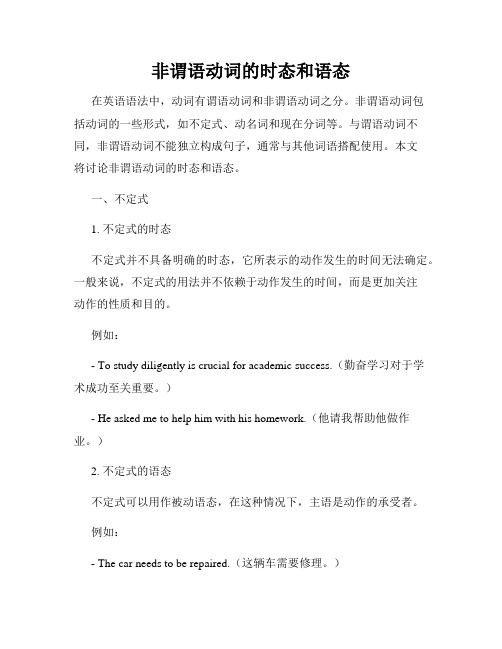
非谓语动词的时态和语态在英语语法中,动词有谓语动词和非谓语动词之分。
非谓语动词包括动词的一些形式,如不定式、动名词和现在分词等。
与谓语动词不同,非谓语动词不能独立构成句子,通常与其他词语搭配使用。
本文将讨论非谓语动词的时态和语态。
一、不定式1. 不定式的时态不定式并不具备明确的时态,它所表示的动作发生的时间无法确定。
一般来说,不定式的用法并不依赖于动作发生的时间,而是更加关注动作的性质和目的。
例如:- To study diligently is crucial for academic success.(勤奋学习对于学术成功至关重要。
)- He asked me to help him with his homework.(他请我帮助他做作业。
)2. 不定式的语态不定式可以用作被动语态,在这种情况下,主语是动作的承受者。
例如:- The car needs to be repaired.(这辆车需要修理。
)- I want to be invited to the party.(我希望被邀请参加派对。
)二、动名词1. 动名词的时态动名词通常表示正在进行的动作或者某个具体事物的特征。
在时态上,动名词一般使用现在分词形式。
例如:- He enjoys swimming in the lake.(他喜欢在湖里游泳。
)- I am sorry for being late.(对于迟到我感到抱歉。
)2. 动名词的语态动名词可以表达被动语态,将be动词和动名词结合使用。
例如:- Being criticized by others is not pleasant.(被别人批评是不愉快的。
)- I remember being told about the party.(我记得有人告诉过我有派对。
)三、现在分词1. 现在分词的时态现在分词常用来表示正在进行的动作或者具体事物的特征,它的时态与句子的主语一致。
非谓语动词的时态和语态在句子中的运用和非谓语动词的种类和非谓语动词在句子中的位置和作用

非谓语动词的时态和语态在句子中的运用和非谓语动词的种类和非谓语动词在句子中的位置和作用非谓语动词指的是不具备主谓关系的动词形式,它可以在句子中充当主语、宾语、状语等成分。
非谓语动词的时态和语态在句子中起到了很重要的作用,并且还有多种类型和不同的位置和作用。
本文将对非谓语动词的时态和语态在句子中的运用、非谓语动词的种类以及非谓语动词在句子中的位置和作用进行探讨。
一、非谓语动词的时态和语态在句子中的运用在句子中,非谓语动词可以使用不同的时态和语态来表达不同的动作状态和语气。
下面是非谓语动词的时态和语态的运用情况:1. 一般式和完成式非谓语动词的一般式常用于表示与主句谓语所表示的动作同时或在之前发生的动作,如:She enjoys dancing.(她喜欢跳舞。
)而完成式常用于表示发生在谓语之前的动作,如:Having finished her work, she went home.(她完成工作后回家了。
)2. 进行式非谓语动词的进行式表示主句谓语所表示的动作正在进行中,如:I saw him running in the park.(我看见他在公园里跑。
)3. 被动语态非谓语动词的被动语态表示主语是动作的承受者,如:The book was written by him.(这本书是他写的。
)二、非谓语动词的种类非谓语动词按照形式可以分为动名词、不定式和分词,它们在句子中具有不同的用法和功能。
1. 动名词动名词是以-ing结尾的动词形式,可以作为主语、宾语、表语、宾补等。
例如:Smoking is harmful to health.(吸烟对健康有害。
)动名词可以用来表示一种习惯或者一般的行为。
2. 不定式不定式是动词的一种形式,可以表达出动作的目的、愿望、能力、推测等。
例如:He wants to learn a new language.(他想要学一门新的语言。
)不定式可以用来表示一个人的目标或者动作的原因。
如何理解非谓语动词的时态与语态
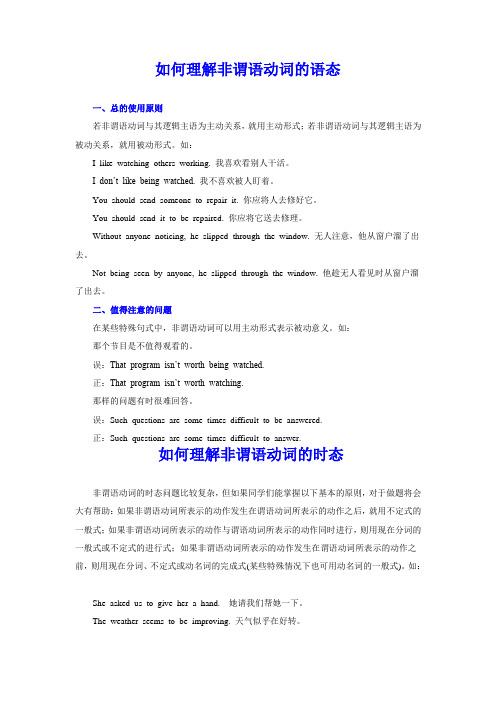
如何理解非谓语动词的语态一、总的使用原则若非谓语动词与其逻辑主语为主动关系,就用主动形式;若非谓语动词与其逻辑主语为被动关系,就用被动形式。
如:I like watching others working. 我喜欢看别人干活。
I don’t like being watched. 我不喜欢被人盯着。
You should send someone to repair it. 你应将人去修好它。
You should send it to be repaired. 你应将它送去修理。
Without anyone noticing, he slipped through the window. 无人注意,他从窗户溜了出去。
Not being seen by anyone, he slipped through the window. 他趁无人看见时从窗户溜了出去。
二、值得注意的问题在某些特殊句式中,非谓语动词可以用主动形式表示被动意义。
如:那个节目是不值得观看的。
误:That program isn’t worth being watched.正:That program isn’t worth watching.那样的问题有时很难回答。
误:Such questions are some times difficult to be answered.正:Such questions are some times difficult to answer.如何理解非谓语动词的时态非谓语动词的时态问题比较复杂,但如果同学们能掌握以下基本的原则,对于做题将会大有帮助:如果非谓语动词所表示的动作发生在谓语动词所表示的动作之后,就用不定式的一般式;如果非谓语动词所表示的动作与谓语动词所表示的动作同时进行,则用现在分词的一般式或不定式的进行式;如果非谓语动词所表示的动作发生在谓语动词所表示的动作之前,则用现在分词、不定式或动名词的完成式(某些特殊情况下也可用动名词的一般式)。
非谓语动词的时态和语态的转换
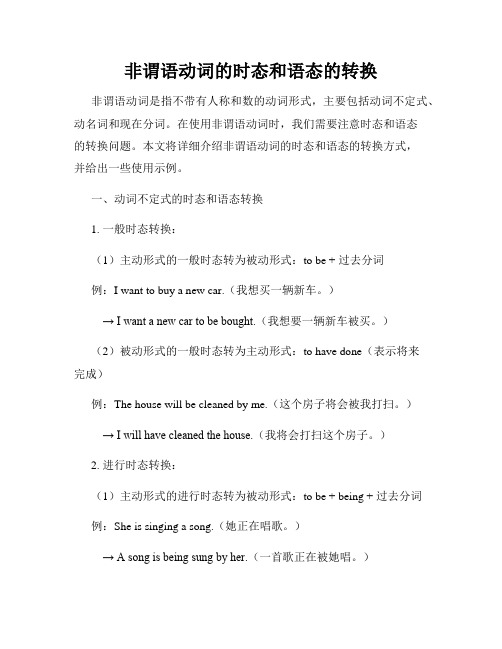
非谓语动词的时态和语态的转换非谓语动词是指不带有人称和数的动词形式,主要包括动词不定式、动名词和现在分词。
在使用非谓语动词时,我们需要注意时态和语态的转换问题。
本文将详细介绍非谓语动词的时态和语态的转换方式,并给出一些使用示例。
一、动词不定式的时态和语态转换1. 一般时态转换:(1)主动形式的一般时态转为被动形式:to be + 过去分词例:I want to buy a new car.(我想买一辆新车。
)→ I want a new car to be bought.(我想要一辆新车被买。
)(2)被动形式的一般时态转为主动形式:to have done(表示将来完成)例:The house will be cleaned by me.(这个房子将会被我打扫。
)→ I will have cleaned the house.(我将会打扫这个房子。
)2. 进行时态转换:(1)主动形式的进行时态转为被动形式:to be + being + 过去分词例:She is singing a song.(她正在唱歌。
)→ A song is being sung by her.(一首歌正在被她唱。
)(2)被动形式的进行时态转为主动形式:to have been being + 过去分词例:The room was being cleaned by the maid.(这个房间正在被女仆打扫。
)→ The maid had been cleaning the room.(女仆一直在打扫这个房间。
)3. 完成时态转换:(1)主动形式的完成时态转为被动形式:to have been + 过去分词例:We have finished the project.(我们已完成这个项目。
)→ The project has been finished by us.(这个项目已由我们完成。
)(2)被动形式的完成时态转为主动形式:to have + done例:The book has been read by him.(这本书已被他阅读。
非谓语动词的时态和语态
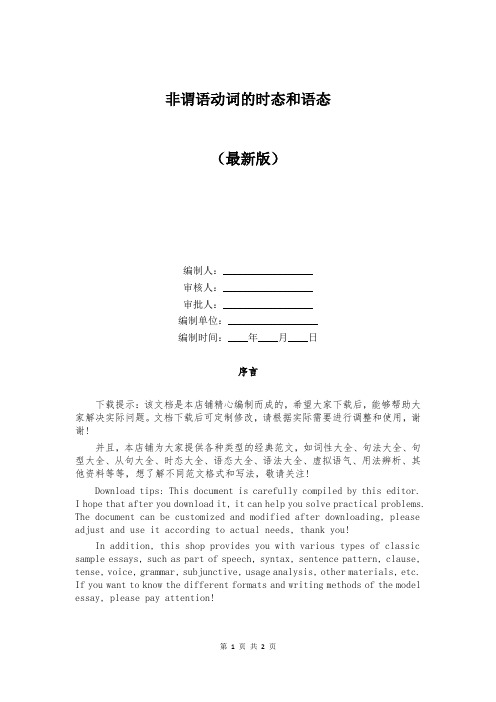
非谓语动词的时态和语态(最新版)编制人:__________________审核人:__________________审批人:__________________编制单位:__________________编制时间:____年____月____日序言下载提示:该文档是本店铺精心编制而成的,希望大家下载后,能够帮助大家解决实际问题。
文档下载后可定制修改,请根据实际需要进行调整和使用,谢谢!并且,本店铺为大家提供各种类型的经典范文,如词性大全、句法大全、句型大全、从句大全、时态大全、语态大全、语法大全、虚拟语气、用法辨析、其他资料等等,想了解不同范文格式和写法,敬请关注!Download tips: This document is carefully compiled by this editor.I hope that after you download it, it can help you solve practical problems. The document can be customized and modified after downloading, please adjust and use it according to actual needs, thank you!In addition, this shop provides you with various types of classic sample essays, such as part of speech, syntax, sentence pattern, clause, tense, voice, grammar, subjunctive, usage analysis, other materials, etc. If you want to know the different formats and writing methods of the model essay, please pay attention!非谓语动词的时态和语态1. 非谓语动词的时态不定式或现在分词的动作若发生在谓语动词的动作之前,用完成式(过去分词没有完成式),否则,就用一般式。
非谓语动词的时态与语态
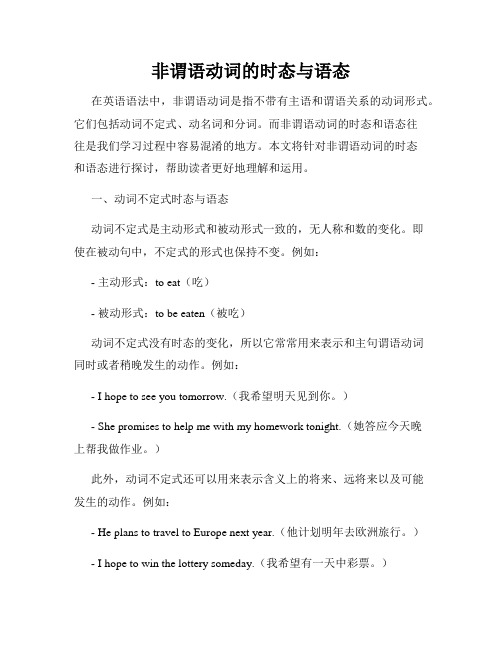
非谓语动词的时态与语态在英语语法中,非谓语动词是指不带有主语和谓语关系的动词形式。
它们包括动词不定式、动名词和分词。
而非谓语动词的时态和语态往往是我们学习过程中容易混淆的地方。
本文将针对非谓语动词的时态和语态进行探讨,帮助读者更好地理解和运用。
一、动词不定式时态与语态动词不定式是主动形式和被动形式一致的,无人称和数的变化。
即使在被动句中,不定式的形式也保持不变。
例如:- 主动形式:to eat(吃)- 被动形式:to be eaten(被吃)动词不定式没有时态的变化,所以它常常用来表示和主句谓语动词同时或者稍晚发生的动作。
例如:- I hope to see you tomorrow.(我希望明天见到你。
)- She promises to help me with my homework tonight.(她答应今天晚上帮我做作业。
)此外,动词不定式还可以用来表示含义上的将来、远将来以及可能发生的动作。
例如:- He plans to travel to Europe next year.(他计划明年去欧洲旅行。
)- I hope to win the lottery someday.(我希望有一天中彩票。
)二、动名词时态与语态动名词在时态和语态上与现在分词相同。
例如:- 主动形式:singing(唱歌)- 被动形式:being sung(被唱)相对于动词不定式,动名词可以表示更早的动作。
例如:- After finishing her work, she went home.(她把工作完成后,回家了。
)- He admitted stealing the money.(他承认偷了那笔钱。
)动名词也可以表示同时进行的动作或者是取决于主句谓语动词发生的动作。
例如:- I love swimming in the ocean.(我喜欢在海里游泳。
)- He enjoys listening to music while studying.(他喜欢一边学习一边听音乐。
高中语法专题解析非谓语动词的时态和语态转换

高中语法专题解析非谓语动词的时态和语态转换非谓语动词是英语语法中的一个重要部分,掌握好非谓语动词的时态和语态转换对于高中学生来说至关重要。
本文将针对非谓语动词的时态和语态转换进行专题解析,帮助同学们更好地理解和运用非谓语动词。
一、时态转换非谓语动词的时态转换主要包括三种形式:不定式、现在分词和过去分词。
1. 不定式不定式作为非谓语动词的一种形式,具有时态转换的特点。
不定式的一般式表示动作在谓语动词之前发生或与谓语动词同时进行;完成式表示动作在谓语动词之前发生。
例如:- To do(一般式): I plan to do my homework after school.(我打算放学后做作业。
)- To have done(完成式): I am glad to have finished my project.(我很高兴已经完成了我的项目。
)2. 现在分词现在分词作为非谓语动词的一种形式,表示同时或被动。
现在分词一般和谓语动词同时进行,常用于进行时态;被动式表示被动。
例如:- Doing(进行时): She is busy doing her homework.(她正忙着做作业。
)- Being done(被动式): The house is being cleaned by the workers.(房子正被工人们清洁。
)3. 过去分词过去分词作为非谓语动词的一种形式,表示完成或被动。
过去分词和谓语动词之间有时间上的先后顺序,一般用于完成时态;被动式表示被动。
例如:- Done(完成时): I have already done my homework.(我已经完成了我的作业。
)- Being done(被动式): The letter was being written when the phone rang.(电话响时,信正在被写。
)二、语态转换非谓语动词的语态转换主要有两种情况:主动语态转换为被动语态和被动语态转换为主动语态。
- 1、下载文档前请自行甄别文档内容的完整性,平台不提供额外的编辑、内容补充、找答案等附加服务。
- 2、"仅部分预览"的文档,不可在线预览部分如存在完整性等问题,可反馈申请退款(可完整预览的文档不适用该条件!)。
- 3、如文档侵犯您的权益,请联系客服反馈,我们会尽快为您处理(人工客服工作时间:9:00-18:30)。
非谓语动词的时态和语态问题
一、非谓语动词的时态问题
不定式或动词的-ing形式(包括现在分词和动名词)的动作若发生在谓语动词的动作之前,用完成式,否则就用一般式。
例:
1.I don’t know whether you happen ________,but I’m going to study in the U. S. A. this September. (辽宁卷)
A. to be heard
B. to be hearing
C. to hear
D. to have heard
【分析】答案选D。
hear发生在谓语don’t know之前,用不定式的完成式。
句意是:我不知道你是否已经听说过了,今年九月我要去美国学习。
2.The old man, ________ abroad for twenty years, is on the way back to his motherland. (江苏卷)
A. to work
B. working
C. to have worked
D. having worked
【分析】答案选D。
work发生在谓语(返回祖国)之前,用现在分词的完成式作状语,表示时间,相当于after he has worked abroad…不定式作状语不能表示时间。
3.“We can’t go out in this weather,” said Bob, ________ out of the window. (四川卷)
A. looking
B. to look
C. looked
D. having looked
【分析】答案选A。
look out of the window与谓语动词said同时发生,用现在分词的一般式作状语,表示伴随情况。
若表示不定式的动作与谓语动作同时发生,并强调正在进行的情景或持续性,可用进行式。
如:
He seems to be reading a newspaper. 他好像在看报。
二、非谓语动词的语态问题
当不定式或动词的-ing形式与其逻辑主语是主动关系,用主动式;是被动关系,用被动式。
如:Little Jim should love ________ to the theatre this evening. (全国卷)
A. to be taken
B. to take
C. being taken
D. taking
【分析】答案选A。
句子主语Little Jim与take是被动关系,“被带去看戏”发生在“想(should lo ve=want)”后,所以用不定式的被动式作宾语。
说明:
①动词不定式用主动形式表被动含义的情况:在作表语或宾补的形容词后用状语时;作定语修饰have, there be, this / that / these / those be等后面的名词或代词时;作表语的to blame等。
如:
1.The text is difficult to learn. 这篇课文很难学。
(to learn主动表被动)
2.We found the text difficult to learn. 我们觉得这篇课文很难学。
(to learn主动表被动)
3.He was to blame for that. 他因此受到了责备。
(作表语的to blame主动表被动)
4.I’m going to the supermarket this afternoon. Do you have anything ________ (上海卷)
A. to be buying
B. to buy
C. for buying
D. bought
【分析】答案选B。
表示“有…要…”,常用不定式的主动形式表示被动含义。
②need, want和require表示“需要”,主语通常是物时,后面除用不定式的被动式外,也可用-ing 形式的主动形式表示被动。
如:
There is a new problem involved in the popularity of private cars ________ road condition s need ________. (上海卷)
A. that; to be improved
B. which; to be improved
C. where; improving
D. when; improving
【分析】答案选A。
need improving=need to be improved。
that引导的从句与problem是同位语。
